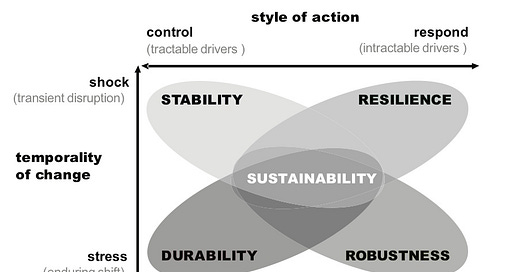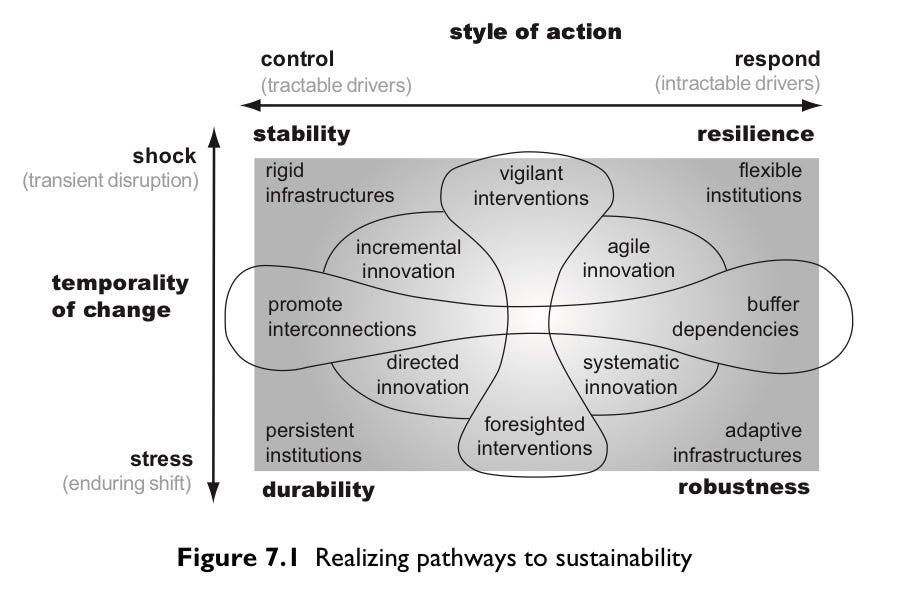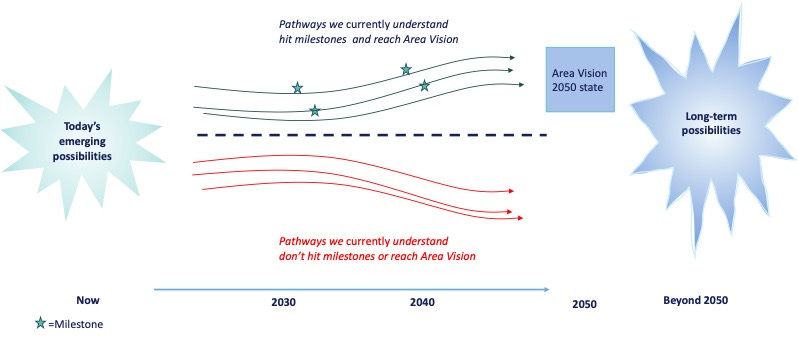Atelier WeekNotes w/c 17 July 2023
Re-starting ReadingNotes. Atelier as Pathways intervention. State of Sustainable Shipping: towards an 'Open Protocol'.
I am writing newsletter of #weeknotes of starting the Atelier of What’s Next (What’s needed, What’s ready? What can we do? What next?). For my rationale for starting the Atelier see here.
This week covers
Re-starting ReadingNotes
Atelier as Pathways intervention
State of Sustainable Shipping: towards an 'Open Protocol'.
Re-starting ReadingNotes
Step: 2/DELIVERING. Theme: Transforming Systems; Atelier Practices.
For a number of years I have had an idea: what if I summarised what I read, partly so I have the notes myself (especially for reading that is part of a project) and partly as a service to others? Could that be a service to the world, an attractor of useful relationships, a way of actually reading more, and of not having to rely on my memory?
Now, I have a good memory. But I know I’ve thought about more when I read something than I can then say later. I assume that summarising will also land the insights for me. Also, I have a reputation for reading and remembering a lot. But there is so much more.
I proposed this as an experiment in Jan 2021. Two years later, before this week, there were 8 entries in the series here, or about 1 a quarter. So, that didn’t really wrk, at least on creating a throughput. What happened?
Well, it all became rather burdensome. When reading, I would underline everything interesting and needed to relate the argument. Then the book or paper would sit on a shelf. When I did (rarely) try to turn it into ReadingNotes, I found myself writing out all of the underlined text, which took far too long.
Back in Jan 21 I had positioned it as an experiment that I would review after a month. I didn’t review it. I kept reading and underlining. Things moved from the ‘To Read’ pile to the ‘To Write ReadingNotes’ pile. Both piles just got larger. As did my guilt.
This week I decided to try again. I have been doing a tonne of reading for the SSI State of Sustainable Shipping in particular. So, I did two more ReadNotes:
‘Transforming the Future: Anticipation in the 21st Century’, edited by Riel Miller here.
‘Causal Layered Analysis: Poststructuralism as method’ by Sohail Inayatullah here
The first of these took me far too long. Admittedly it was 3 chunky chapters of a very dense (and very badly written) book. But, interestingly, the summarising did force me to think though what I thought its key points were, and improved my appreciation. The second (a 12 page futures classic) I read and summarised in lass than a couple of hours.
I have a few of my favourite books that are waiting to be summarised, so then I can integrate them more into my practice.
So, doing these ReadingNotes was useful. But that was true before. I might be learning to summarise quicker (though more track record on this needed).
What might take me out of ‘overwhelmed by guilt’ into ‘making some progress’? Perhaps a goal to do one ReadingNotes per working week (I have a lot of holiday coming up over Aug). And a genuine stage gate date of ‘continue / change / stop’ of the end of Sep.
WHAT NEXT
A ReadingNote per working week to the end of Sep.
End of Sep as a Stage Gate. So, there will be a judgement in the WeekNotes for w/c 25 Sep.
Atelier as Pathways intervention
Step: 2/DISCOVERING. Theme: Transforming Systems. Atelier Practices.
One of the other things I have been reading for State of Sustainable Shipping is the outputs of the STEPS Centre, which, between 2006 and 2021, carried out interdisciplinary global research uniting development studies with science and technology studies. STEPS stands for Social, Technological and Environmental Pathways to Sustainability.
Now, I will be doing some ReadingNotes on these (honest). Plus I feel a bit embarrassed that I didn’t look into their work earlier, for instance when I was at Forum for the Future. For now I just wanted to explore one of their core concepts and what it means for an Atelier of What’s Next.
First, the set up. The STEPS authors define sustainability as “the capability of maintaining over indefinite periods of time specified qualities of human well-being, social equity and environmental integrity.” (What those qualities are and who gets to decide which get maintained is something we will have to leave for another time.)
Different abilities to influence events (which they refer to as ‘styles of action’ and the timeframe of the event (the ‘temporality of change’) have different needs, when it comes to being sustainable.
The context provides different challenges to maintaining well-being, equity and environmental integrity.
Therefore, ‘sustainability’ is formed of having access to different dynamic properties (see diagram).
Stability: by controlling sources of short-term episodic shocks.
Resilience: by responding effectively to short-term episodic shocks.
Durability: by controlling sources of long-term stress.
Robustness: by responding effectively to long-term enduring stress.
From this, The STEPS Centre authors then have 12 interventions that are appropriate to the dynamics that you are facing (shock or long-run, controllable or not).
I hadn't come across this before, and so was wondering what would be revealed by applying it to my original rationale for Atelier for What's Next. The short version (about the world in general, rather than about myself) was in this paragraph:
"We live in powerful times. Lots of changes are happening, more are coming — whether we like it or not. We need the capacity to respond, to turn concepts into reality, to take what is available through to what is needed. The capability of an 'Atelier of What's Next' has the possibility of a strong contribution."
Looking at the time dimension, that original rationale includes (implicitly) both shocks and stresses. In my mind, part of 'powerful times' stands for ever-more, ever-faster shocks caused by stresses. The short-term increasingly made up of emergencies, as we struggle to adjust to long-term changes.
On the control dimension, I was thinking much more of responding than controlling. I think we've unleashed changes in the natural world which we, as the totality of humankind, cannot control, let alone what an Atelier of What's Next can do.
The conclusion: an Atelier of What's Next is an 'adaptive infrastructure', looking to respond to the long-term trends (rather than trying to control them, or to deal with short-term crises only).
The nuance is that the the things that go through the studio could, in principle, be aiming for any of the different points across that 'time vs control' space. Let's map a few of the current items:
State of Sustainable Shipping (SoSS). Persistent Institution. The dominant presumption is that the key players in the shipping industry can have such influence and investment that they have (a larger degree of) control. Again, there is this double movement, where the action generated by the SoSS could be across the 'time vs control' dynamics space.
Net Zero Heat Innovation Lab (NZHIL). Directed Innovation. The purpose is to generate innovation on non-industrial heat in the UK, which can move through commercial demonstration quickly.
Using Time Well. Persistent Institution. The idea is to provide an on-going social learning cycle, so that health and care practitioners are able to use emerging good practices to navigate the tensions between quality engagement and bureaucratic demands (effectiveness vs efficiency).
WHAT NEXT. Bring more of the STEPS Centres tools and conclusions into my practice and work.
State of Sustainable Shipping: towards an 'Open Protocol'.
Step. 4/DEVELOPING. Themes. Catalysing sectoral transformations. Scanning.
The State of Sustainable Shipping (SoSS) with the Sustainable Shipping Initiative (SSI) is one of my big current projects (featured in past WeekNotes: first here, second here). Purpose (in one line): to accelerate change on specific sustainability issues within the maritime sector, by tracking and challenging the industry’s progress in ways that stimulate action, using the pre-exising Roadmap.
This week has been about trying to create an Open Protocol. The Open Protocol describes the method of delivering the SoSS, put in the public domain to gain feedback, increase credibility and provide others with inspiration for their own domain.
One of my pet hates about responding to a tender is when the client has specified the outputs and the method. Tell me the outputs and the context, and then trust me to come up with a proposed method, which we can than finalise together.
The version I was working on this week gives specifications for key components and steps in the SoSS approach. The idea is that these specifications are enough for the different elements to be delivered by different organisations (with oversight from SSI). This should allow for flexibility depending on resources, financing and skills available, while maintaining coherence across the whole project.
The specifications detail the outputs and the qualities of process for delivery. The delivery organisation can propose whatever specific method they believe will succeed, within the given budget and timeframe. Thus, this allows the SoSS to be enriched by the deliver organisations coming up with the method for each step, which could well be one that we could not have thought of.
This is the purpose behind the research on Futures Literacy and STEPS Centre Pathways (see above). There's lots, currently with the SSI Secretariat for the first round of feedback. I hope to put the improved version in a future WeekNotes so that readers have their own chance to comment.
For now, I just want to share this diagram:
It is easy to default to see ‘the future’ as having one or more fixed pre-existing pathways. That would make the task of SoSS as finding those pathways, measuring progress and recommending next steps.
But, in my view, a more complete view is that ‘the future’ is emerging in the present. Therefore, the task of SoSS is for people make-sense of the present so that they imagine different ways forward, which change their investment decisions and their understanding of how the shipping industry changes.
In short, the pathways are made by walking, not by observing. This approach allows for greater agency and creativity.
WHAT NEXT. Feedback from the SSI Secretariat, and then opening up to others. Piloting the whole approach on the Vision Area of Oceans, aiming to finish the cycle in Spring 2024.






